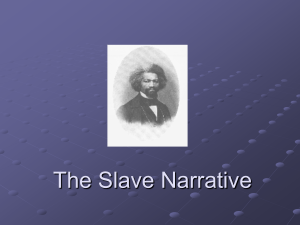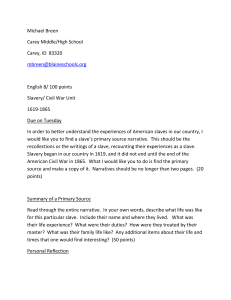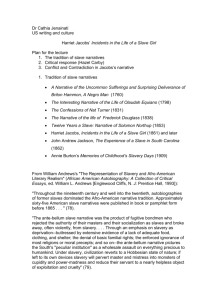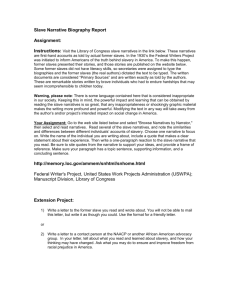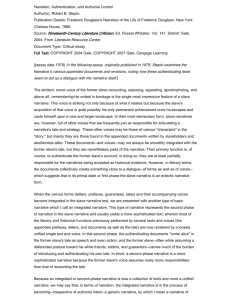SLAVE NARRATIVES
advertisement
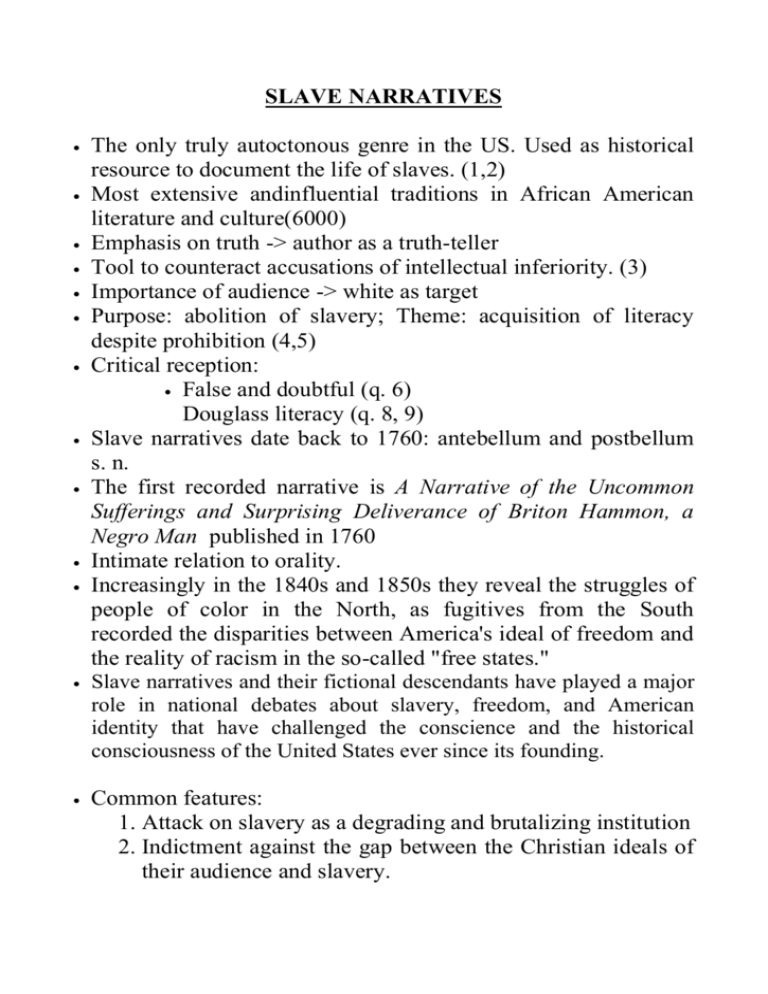
SLAVE NARRATIVES ● ● ● ● ● ● ● ● ● ● ● ● ● The only truly autoctonous genre in the US. Used as historical resource to document the life of slaves. (1,2) Most extensive andinfluential traditions in African American literature and culture(6000) Emphasis on truth -> author as a truth-teller Tool to counteract accusations of intellectual inferiority. (3) Importance of audience -> white as target Purpose: abolition of slavery; Theme: acquisition of literacy despite prohibition (4,5) Critical reception: ● False and doubtful (q. 6) Douglass literacy (q. 8, 9) Slave narratives date back to 1760: antebellum and postbellum s. n. The first recorded narrative is A Narrative of the Uncommon Sufferings and Surprising Deliverance of Briton Hammon, a Negro Man published in 1760 Intimate relation to orality. Increasingly in the 1840s and 1850s they reveal the struggles of people of color in the North, as fugitives from the South recorded the disparities between America's ideal of freedom and the reality of racism in the so-called "free states." Slave narratives and their fictional descendants have played a major role in national debates about slavery, freedom, and American identity that have challenged the conscience and the historical consciousness of the United States ever since its founding. Common features: 1. Attack on slavery as a degrading and brutalizing institution 2. Indictment against the gap between the Christian ideals of their audience and slavery. ● 3. They also used the gap between Political ideals and slavery. 4. These concerns structures a pattern that was constantly repeated consisting of several phases: o Description of bondage and attack on it. o Decision to escape encouraged by some personal crisis o Quest for freedom o Freedom signified by renaming oneself and dedicating one’s future to antislavery activism 5. Their status as communal voice, they represent the slave community. 6. Structure of the narrative: intro, narrative and appendixes According to stepto, 3 kinds of Phases of narration: 1. Basic 1->eclectic-> authenticating documents are appended to the tale 2. Basic 2->Integrated narrative -> authenticating documents are integrated in the Tale –Equiano 3. “Generic narrative”: Authenticating documents are subsumed by the tale -> identifiable generic text= autobiography; the narrative voice becomes the most important one: Douglass. “Authenticating Narrative”: The tale is subsumed by the authenticating strategies -> novels, histories Frequent Pattern: From Frances Smith Foster, Witnessing Slavery: The Development of Ante-bellum Slave Narratives, [2d. ed., 1994]: "The plot of the nineteenth-century slave narrative is informed by the JudeoChristian mythological structure on both the material and the spiritual levels. The action moves from the idyllic life of a garden of Eden into the wilderness, the struggle for survival, the providential help, and the arrival into the Promised Land. In addition, the plot of the slave narrative incorporates the parallel structure of birth into death and death into birth which also distinguishes the JudeoChristian myth" (84). "In the slave narrative the mythological pattern is realized in four chronological phases. First comes the loss of innocence, which is objectified through the development of an awareness of what it means to be a slave. This can be compared to the descent from perfection or mortification. The mortification process includes purgation, for as the slave learns the meaning of slavery, he also tries to purge himself of those elements that would facilitate enslavement. Second is the realization of alternatives to bondage and the formulation of a resolve to be free. This decision begins the ascent to the ideal, or invigoration. The resolution to quit slavery is, in effect, a climax to a conversion experience. The third phase is the escape. Whether it occurs between two sentences or forms the largest portion of the narrative, it is part of the struggle to overcome evil. The interest at this point is in the details, the pitfalls and obstacles, the sufferings and moments of bravery encountered in the process of achieving freedom. Although the first attempt sometimes ends in capture, the outcome is never in doubt. The narrative, after all, was written by a freeman. The fourth phase is that of freedom obtained. It is the arrival at the City of God or the New Jerusalem and it corresponds to the jubilation period of ancient ritual" (85). Descent from state of innocence or peace into recognition of status (slavery) Progressive dehumanization at hands of masters and concomitant growth of self-reliance and decision-making, sometimes involving literacy A spiritual "bottoming-out" Resolve; for Douglass, the fight with Covey Flight and redemption Frequently Repeated Motifs Exposes physical and emotional abuses of slavery: scenes of whipping, sexual abuse, starvation, especially of women or children Exposes (sometimes satirically) white owners' hypocrisy and inconstancy Describes repeated raising of narrator's expectations only to have them dashed by whites Describes quest for literacy Describes quest for freedom Includes vignettes of other character types and the experience of slavery: those who succeed and those who fail Makes overt appeals to imagined audience Details loss of significant family member(s) and the destruction of family ties
